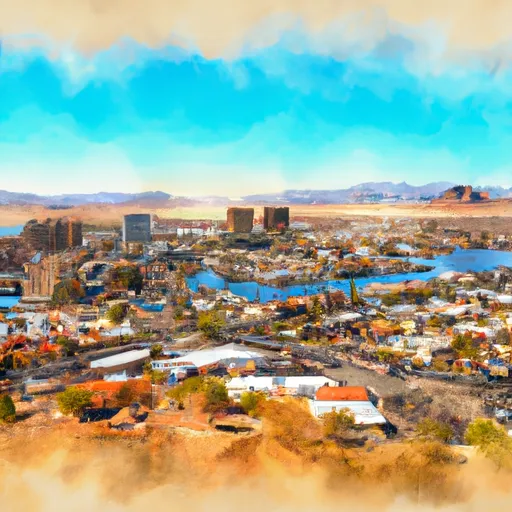-
 Snoflo Premium
Snoflo Premium
Get unlimited access to all our content
With no Ad interruptions! - Start Your Free Trial Login with existing account
Lake-Havasu-City
Eden Index
Climate
7.7
•
Recreation
6.8
•
Community
2.4
•
Safeguard
6.0/10

Lake Havasu City is a scenic desert community located in Mohave County, Arizona. With its picturesque setting, the city is best known for its warm climate, blue skies, and abundant sunshine. Summers in Lake Havasu City are scorching, with temperatures often exceeding 100 degrees Fahrenheit, while winters are mild and comfortable, rarely dipping below 40 degrees Fahrenheit. This pleasant climate makes the city a popular year-round destination for outdoor enthusiasts.
Lake Havasu, created by the Parker Dam on the Colorado River, is a major hydrological feature of the area. The lake not only provides a stunning backdrop for the city but also offers various water-based recreational opportunities. Boating, fishing, kayaking, and waterskiing are popular activities enjoyed by locals and visitors alike. Additionally, the lake is renowned for its London Bridge, which was relocated brick by brick from England in the 1960s.
Apart from water activities, Lake Havasu City offers a wide range of outdoor recreation opportunities. The surrounding desert landscape is perfect for hiking, off-roading, and exploring the stunning desert flora and fauna. Golfing enthusiasts can enjoy several championship golf courses in the area. With its unique climate, hydrology constituents, and diverse outdoor activities, Lake Havasu City is a haven for those seeking both relaxation and adventure.
What is the Eden Index?
The Snoflo Eden Index serves as a comprehensive rating system for regions, evaluating their desirability through a holistic assessment of climate health, outdoor recreation opportunities, and natural disaster risk, acknowledging the profound impact of these factors on livability and well-being.
Climate Health Indicator (CHI): 7.7
Lake-Havasu-City receives approximately
180mm of rain per year,
with humidity levels near 47%
and air temperatures averaging around
22°C.
Lake-Havasu-City has a plant hardyness factor of
10, meaning
plants and agriculture in this region tend to thrive here all year round.
By considering the ideal temperature range, reliable water supplies, clean air, and stable seasonal rain or snowpacks, the Climate Health Indicator (CHI) underscores the significance of a healthy climate as the foundation for quality living.
A healthy climate is paramount for ensuring a high quality of life and livability in a region, fostering both physical well-being and environmental harmony. This can be characterized by ideal temperatures, reliable access to water supplies, clean air, and consistent seasonal rain or snowpacks.
Weather Forecast
Streamflow Conditions
Lower Colorado
Area Rivers
Lower Colorado
Snowpack Depths
Lower Colorado
Reservoir Storage Capacity
Lower Colorado
Groundwater Levels
Recreational Opportunity Index (ROI): 6.8
The Recreational Opportunity Index (ROI) recognizes the value of outdoor recreational options, such as parks, hiking trails, camping sites, and fishing spots, while acknowledging that climate plays a pivotal role in ensuring the comfort and consistency of these experiences.
Access to outdoor recreational opportunities, encompassing activities such as parks, hiking, camping, and fishing, is crucial for overall well-being, and the climate plays a pivotal role in enabling and enhancing these experiences, ensuring that individuals can engage in nature-based activities comfortably and consistently.
Camping Areas
| Campground | Campsites | Reservations | Toilets | Showers | Elevation |
|---|---|---|---|---|---|
| La Paz County Park | 150 | 376 ft | |||
| Buckskin State Park | 89 | 426 ft | |||
| Cattail Cove State Park | 61 | 497 ft | |||
| Crossroads | 12 | 393 ft | |||
| Needle Mt Road Dispersed | None | 808 ft | |||
| Empire Landing | 56 | 382 ft | |||
| Lake Havasu State Park | 42 | 1,015 ft | |||
| Lake Havasu Dispersed - RT 95 Area | None | 799 ft | |||
| Moabi Regional Park | 150 | 479 ft | |||
| River Island - Buckskin State Park | 37 | 393 ft |
Nearby Fishing
Nearby Ski Areas
Catastrophe Safeguard Index (CSI):
The Catastrophe Safeguard Index (CSI) recognizes that natural disaster risk, encompassing floods, fires, hurricanes, and tornadoes, can drastically affect safety and the overall appeal of an area.
The level of natural disaster risk in a region significantly affects safety and the overall livability, with climate change amplifying these risks by potentially increasing the frequency and intensity of events like floods, fires, hurricanes, and tornadoes, thereby posing substantial challenges to community resilience and well-being.
Community Resilience Indicator (CRI): 2.4
The Community Resilience Indicator (CRI) recognizes that education, healthcare, and socioeconomics are crucial to the well-being of a region. The CRI acknowledges the profound impact of these elements on residents' overall quality of life. By evaluating educational resources, healthcare accessibility, and economic inclusivity, the index captures the essential aspects that contribute to a thriving community, fostering resident satisfaction, equity, and social cohesion.

